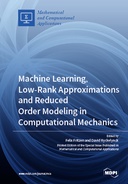Explore

Machine Learning, Low-Rank Approximations and Reduced Order Modeling in Computational Mechanics
Felix Fritzen and David Ryckelynck
2019
0 Ungluers have
Faved this Work
Login to Fave
The use of machine learning in mechanics is booming. Algorithms inspired by developments in the field of artificial intelligence today cover increasingly varied fields of application. This book illustrates recent results on coupling machine learning with computational mechanics, particularly for the construction of surrogate models or reduced order models. The articles contained in this compilation were presented at the EUROMECH Colloquium 597, « Reduced Order Modeling in Mechanics of Materials », held in Bad Herrenalb, Germany, from August 28th to August 31th 2018. In this book, Artificial Neural Networks are coupled to physics-based models. The tensor format of simulation data is exploited in surrogate models or for data pruning. Various reduced order models are proposed via machine learning strategies applied to simulation data. Since reduced order models have specific approximation errors, error estimators are also proposed in this book. The proposed numerical examples are very close to engineering problems. The reader would find this book to be a useful reference in identifying progress in machine learning and reduced order modeling for computational mechanics.
This book is included in DOAB.
Why read this book? Have your say.
You must be logged in to comment.
Rights Information
Are you the author or publisher of this work? If so, you can claim it as yours by registering as an Unglue.it rights holder.Downloads
This work has been downloaded 323 times via unglue.it ebook links.
- 38 - pdf (CC BY-NC-ND) at Unglue.it.
Keywords
- 3D reconstruction
- a priori enrichment
- Archive
- Artificial Neural Networks
- computational homogenisation
- computational homogenization
- Data science
- DEIM
- dynamic extrapolation
- ECSW
- elasto-viscoplasticity
- elastoviscoplastic behavior
- empirical cubature
- empirical cubature method
- enhanced POD
- error indicator
- finite deformation
- gappy POD
- geometric nonlinearity
- GNAT
- Hamiltonian system
- Hencky strain
- heterogeneous data
- hyper-reduction
- inverse problem plasticity
- large strain
- low-rank approximation
- Machine learning
- microstructure property linkage
- modal analysis
- model order reduction
- model order reduction (MOR)
- model reduction
- Neural Network
- nonlinear material behaviour
- nonlinear reduced order model
- nonlinear structural mechanics
- parameter-dependent model
- PGD compression
- POD
- proper generalised decomposition (PGD)
- proper orthogonal decomposition
- proper orthogonal decomposition (POD)
- proper symplectic decomposition (PSD)
- randomised SVD
- reduced basis
- reduced integration domain
- reduced order modeling (ROM)
- reduced-order model
- Sampling
- snapshot proper orthogonal decomposition
- stabilization
- structure preservation of symplecticity
- supervised machine learning
- surrogate modeling
- symplectic model order reduction
- tensor-train decomposition
- Unsupervised machine learning
Links
DOI: 10.3390/books978-3-03921-410-5Editions


